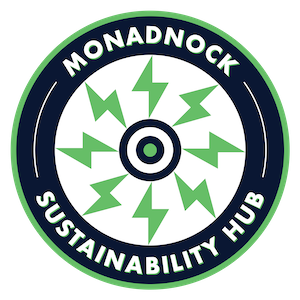By Nora E. Hanke, Program Manager at Monadnock Sustainability Hub.
Originally published in The Monadnock Shopper News, Green Monadnock column, July, 2023
We might feel helpless or hopeless about the new-normals of extreme weather and rising global temperatures. This month, Granite Staters saw damaging floods – again. We also experience droughts more often. Forest fires from an unprecedented heat have been polluting the air. A May deep freeze destroyed fruit crops and harmed trees. The common theme is climate change, according to national experts and our state climatologist. Its cause is emissions from burning fossil fuels (coal, oil, and gas).
“Weird weather” is costly to each of us, one way or another. Severe rain and droughts are expensive for farmers, home- and property owners. Nature-lovers worry about harm to wildlife and habitats. When buildings flood, roads wash out or air quality is hazardous, we are inconvenienced, and can be injured – or worse. The late freeze harms not just orchardists, but also those who buy or eat fruit.
Drastically cutting carbon emissions is the key to “turn the ship”. How fast we do it matters.
We have social natures, observing and copying each other. We can be problem-solvers, too. “You have to…try to make things better. As much as you can,” said the Montana youth Nikki Held earlier this year.
One way people in the Granite State are stepping up is through advocacy for community power (CP). Recent state legislation enabled the creation of this alternative to default supply from our utilities. CP offers electricity that is likely to be cheaper, can ramp up regional renewable power generation, and yields more local jobs that pay well. Poles, wires and other infrastructure remain the utilities’ responsibility.
The plan’s mix can enhance renewable sourcing compared to our utilities’ retail supply. Billing features may create new funding for local energy projects such as building retrofits that diminish reliance on fossil fuels.
New Hampshire energy policies lag behind other states’. Our utilities must source only 23.4% of their power from renewables, rising to max-out at 25.2% in 2025. Other New England states call for higher proportions of renewables, and continue to raise standards beyond 2025. In part because renewable pricing has been falling, our residential electricity prices exceed those of every state except Hawaii. Based on policy factors, NH also ranks lowest in the region for energy efficiency, according to the American Council for an Energy-Efficient Economy.
Drivers of new renewable energy production are principally policy, economics and voluntary actions. Lacking supportive state policies, in NH it is declining prices for renewables along with residents’ demands that can grow renewables, cut ratepayer prices and meaningfully reduce our carbon emissions.
Renewable energy sources include wind, solar, hydro, biomass, and methane from waste. CP plans offer members choices for renewable proportions, all the way to 100% renewables, but the default choice is important. The default is the mix that residents and business customers will be enrolled in unless they take action to change, or opt-out. 95% or more enrollees stick with the default.
Plans whose default moves a town’s residents and business owners to more renewables result in more money in the state pot to reward existing clean energy producers (including residents with solar), and for new clean power project grants.
As a result of its game-changing promise, the state’s ratepayer advocate, Don Kreis, said, “I strongly urge you to take [the opportunity to adopt community power],” when speaking to town representatives at a meeting in Keene last month.
This spring CP programs launched in Walpole, Swanzey, Peterborough, Marlborough, Keene, and Harrisville. Most towns chose a default that bumped-up renewable sourcing by 10%. Encouragingly, initial prices for every choice in all plans – including 100% renewables – beat the utilities’ prices. CP prices taking effect August 1 continue to show savings for members.
Community power took work by town volunteers. Now there are model plans for others to adapt. Citizen leadership can yield rises in renewable power demand and production, by increasing renewable proportions in the default option, and other plan details. Program managers can funnel revenue into local projects that further reduce our reliance on fossil fuels.
When plans result in a shift away from fossil fuel sources of electricity, community power turns hope for our climate into action – and all NH residents can participate.
Nora E. Hanke is Program Manager at Monadnock Sustainability Hub. She has an MS in Environmental Studies from Antioch University New England, and previously worked in medicine. MSH partners with Southwest Region Planning Commission to offer Select Boards and Energy Committees presentations about Community Power. To arrange a visit to your town, email her at nhanke@monadnocksustainabilityhub.org.

